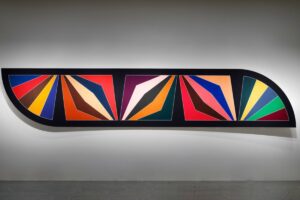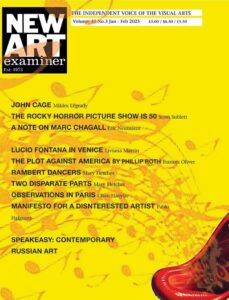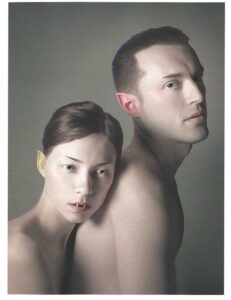

Writing about art is an art in itself. I join in with the cliché, ‘I don’t know much about art but I know what I like.’
For years I assumed that it’s in the seeing that believing comes. Now I feel it’s become the other way round, as in religion where believing affects the seeing, perhaps. The media critics are the priests of the arts and they have the power to turn art into an illustration for their text. Has modern art joined forces with the literary movement? To get the right understanding, must I first read about the artist and what it is I am staring at?
How dare I put forth the notion that modern art has trouble standing upright without an explanation next to it? Is it more complex than that? As the collective consciousness grows and evolves, we too develop and evolve and art plays a function in mirroring this.
While we drop what’s unnecessary, release old, well-worn ideas, hone down the elaborate, streamline and smooth off towards less-is-more imagery, is there a place still for the detailed and realistic art that does not require explanations? Even recording epic events in paintings is no longer vitally important, for we have the smart phone to capture this.
Then where are we heading? Like weather predictions, none of us really knows what to expect from the future. But because we aren’t comfortable in the not knowing – we have allowed the rise of a myriad of ‘experts’ who inform and direct us to ‘believe’ in the latest trends and what is deemed worthy and unworthy. Are the beneficiaries of these predictions related to a financial set-up already agreed with an established gallery?
Looking at the newest, most innovative creations emerging from inside art colleges should be exciting, uplifting and thought provoking. Great Britain won its greatness not only for penetrating the globe with colonisation but also for its edgy artists, writers, designers and musicians. Years of studying, exploring and experimenting in the colleges were meant to nurture the imagination to flourish in nourishing soil. But has the consensus become so loud and so influential that the art being produced today is a weak response from nervous students, many of whom have had to borrow heavily for financial support to study?
Degree shows often reflect this restriction in what should be the blossoming of new ideas. Instead, like badly grown seedlings struggling in weak soil, exhibitions show creations that are diluted forms from yesteryear, installations accompanied with scraps of paper explaining something that could resemble the contents of the artist’s waste bin.
How difficult is it for the newly forming artists to puncture the accepted already-done art? And is it ever possible to do this? Consider Solomon’s famous dictum:
“There’s nothing new under the sun. What has been will be again, what has been done will be done again; there is nothing new under the sun.”
This is often used as a world-weary complaint about life’s monotony. When Solomon wrote the statement, he was emphasising the cyclic nature of human life on earth and the emptiness of living only for the ‘rat race’.
Our ability to express something beyond what has already been created is perhaps an impossible task. Instead, art must keep evolving in its repetition of what has already been, but with the creator’s own signature to make it different. Maybe all that is lacking today is the confidence to go against the consensus by expressing the imagination without needing validation?
The struggling artist determined to reject commercial viability, despite not being able to afford this independence of expression, is obliged to continue the ‘starving artist in the garret’ cycle until they are ‘discovered’ and given recognition. But then, doesn’t the neat packaging from the critics’ acceptance appear?
When Miles Davis stopped mimicking his heroes and waiting for approval from the critics he said, “Man, sometimes it takes you a long time to sound like yourself. Don’t play what’s there; play what’s not there.”
Perhaps what needs to be addressed first, before any attempt to create, is how to gain confidence in the self’s desire to express the imagination. Sadly, this often doesn’t arise until becoming financially comfortable.
Sea Warrior
Volume 34 no 3 January – February p 22 -23
(Sea Warrior is the preferred pseudonym of one of Penzance writers’ group)


Sea Warriot, Wow, I so agree with you, and have used similar metaphors and analogies to describe the deplorable state of contemporary art. One good reply comes from a TED talk by the late Denis Dutton: “A Darwinian Theory of Beauty” Denis Dutton was a respected philosophy professor and the editor of Arts & Letters Daily. In his book The Art Instinct, he suggested that humans are hard-wired to seek beauty.
Aesthetic taste, argues Dutton, is an evolutionary trait, and is shaped by natural selection. It’s not, as most contemporary art criticism and academic theory would have it, ‘socially constructed.’ The human appreciation for art is innate, and certain artistic values carry across cultures. It seems an aesthetic perception ensured the survival of the perceiver’s genes. What does that mean for the entire discipline of art history? Dutton argues, with forceful logic and hard evidence, that art criticism needs to be premised on an understanding of evolution, not on abstract ‘theory’.
If we base art criticism on evolutionary biology, then we arrive at a solid understanding of art’s role in human evolution, in the social function and purpose of art. We are then also able to trust ourselves and believe in ourselves. The last 40 years of post modern thought favored the counter=aesthetic, what we don’t like and wouldn’t want. This was said to be the most exciting art of our time, and if you disagreed, you might lose your teaching job. But now after 30-40 years, we’ve had enough. As you said, it is in the seeing that we discover the truth, in personal sensory and intuitive response. If academics disagree, it’s because they want to control the narrative, but science proves them wrong. If we believe in our own instincts, then charlatans cannot hold sway.
https://www.ted.com/talks/denis_dutton_a_darwinian_theory_of_beauty?language=en
Thank you Miklos for drawing our attention to Denis Dutton”s talk “A Darwinian Theory of Beauty”, which in my opinion is a much-needed consideration that could lead us from out under the weight of the art world – I mean museum and academic culture. They are handicapped as both need cash flow to keep their doors open, a dilemma shared with politicians. The suggestion that humans are hardwired to seek beauty lies outside the so-called discourse of post modernism and maybe modernism. I would be interested to hear any opposing views or considerations. As cultural and art fashion is made inside media (including the NAE), I am interested in the idea of change. Today we have given up the idea that the new (avant-garde) is progressive. So where does the pendulum point to? There is one thought I like: what is fashionable today will not be tomorrow. Just look at previous issues of Vogue or yesteryear car designs.
In a very hidden way, “beauty” at some time or another, must have had an unnoticed role in the very act of what it was to survive, not to mention thrive. This is secret now, almost reptilian, very primal, very precognition but vital. You cannot program vitality into AI. You can suggest what might comprise beauty but never disclose it as a certainty or, for that matter, even “knowable”. We may not agree on beauty, however there maybe some consent or instinctual function that defies explanation that is somehow transferred.
Gothic churches are beautiful. Does anyone disagree? They were not” unnoticed”
OH they are quite noticed, accepted and praised and used as a mode of life… find me a contemporary structure that would be wholly accepted as a truthful act of “beauty” and the problem rears up in a thunder of disturbance…. provoking wide disagreement as issues of “taste” surface , ideas of style preference creep in the entire notion of the “lost past” becomes haunting… and the notion of “beauty” is plunged down.
Great read, very thought provoking.